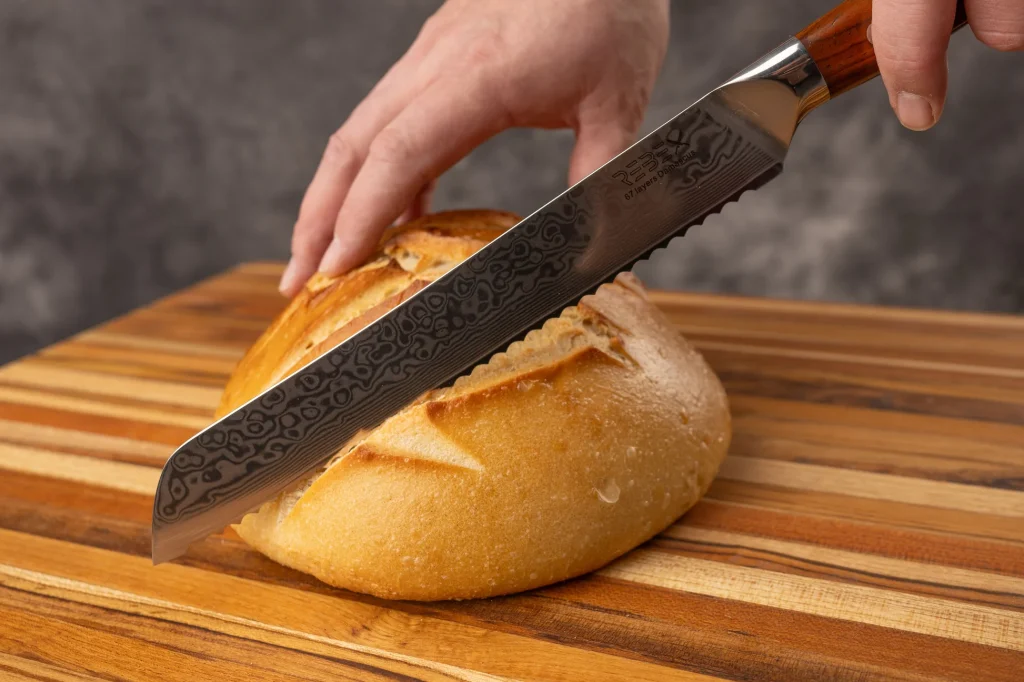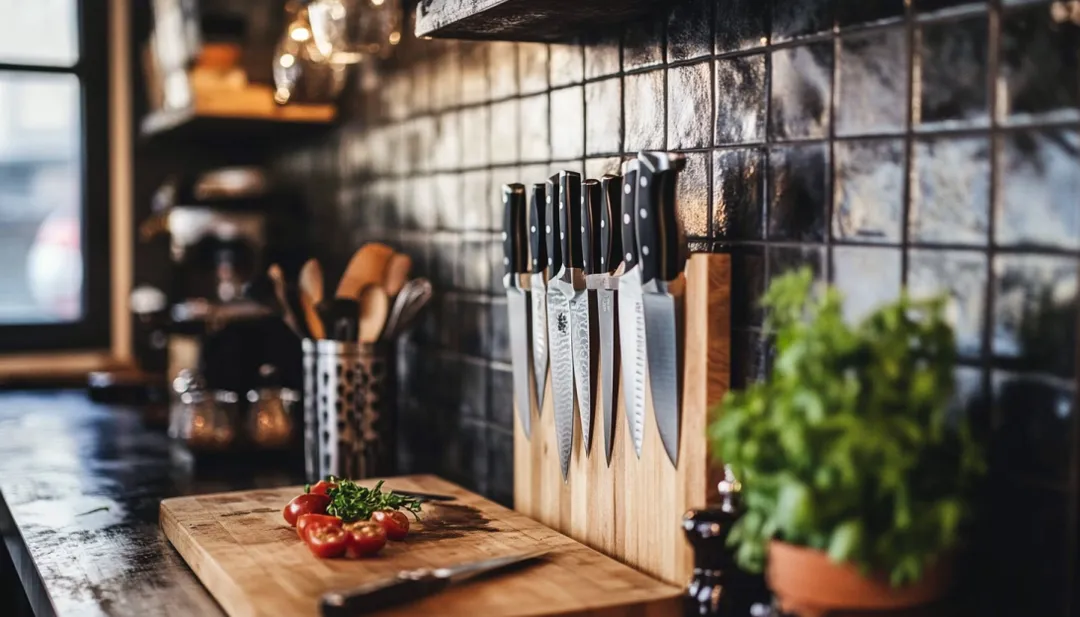Whether you’re a seasoned professional or an enthusiastic home cook, the right knife can make all the difference in your culinary experience. In fact, every chef will tell you that having a well-rounded knife collection is the foundation of any great kitchen. But with so many options on the market, it can be overwhelming to figure out where to start. That’s why we’ve put together this guide on the 3 knives that are essential for a chef, helping you craft amazing dishes with ease and precision.

1. The Chef’s Knife – The All-Purpose Workhorse
When discussing the 3 knives essential for a chef, the first and most important is the chef’s knife. This is often referred to as the “workhorse” of the kitchen, and for good reason. With its versatile 8 to 10-inch blade, the chef’s knife is capable of handling most of your cutting, chopping, and slicing tasks with ease.
Why It’s Essential:
- Versatility: From mincing garlic to slicing through thick cuts of meat, a chef’s knife can tackle nearly any task.
- Comfort: The wide blade allows you to use a rocking motion, which makes it easier to chop quickly without sacrificing accuracy.
- Durability: A well-made chef’s knife will last for years, making it a solid investment in your kitchen tools.
In essence, if you were to only invest in one knife, this should be it. The chef’s knife is perfect for both small and large tasks, saving you from switching between multiple blades as you prep. Invest in a high-quality chef’s knife, and you’ll immediately notice the difference in your food prep efficiency.

2. The Paring Knife – Precision at Its Best
Next on the list of 3 knives that are essential for a chef is the paring knife. While the chef’s knife can handle bigger jobs, the paring knife is your go-to for delicate, precise tasks. Typically, these knives have a blade of about 3 to 4 inches, making them ideal for peeling, trimming, and detailed slicing.
Why It’s Essential:
- Precision: The small size and sharp blade allow you to handle intricate tasks, such as deveining shrimp or peeling fruits and vegetables.
- Control: The paring knife’s lightweight nature makes it easy to maneuver, offering you complete control over the smallest cuts.
- Compact Design: It’s easy to store and doesn’t take up much space in your kitchen, but it still packs a punch in terms of functionality.
While a chef’s knife may feel cumbersome for delicate work, the paring knife steps in to provide the finesse needed for detail-oriented tasks. It’s the perfect tool when you need to add a professional touch to your food presentation, like creating garnishes or making fine cuts for plating.

3. The Serrated Bread Knife – Cutting Through Tough Exteriors
Rounding out the 3 knives essential for a chef is the serrated bread knife. This knife is often overlooked but plays a critical role, especially when it comes to cutting through foods with tough exteriors and soft interiors. The blade of a bread knife typically ranges from 8 to 10 inches and features a saw-like edge that easily slices through crusty breads and delicate cakes without tearing them apart.
Why It’s Essential:
- Perfect for Breads and Cakes: Its serrated edge grips and cuts through hard surfaces without crushing the soft insides, making it a must for anyone who loves baking.
- Versatility Beyond Bread: In addition to bread, this knife works wonders on other tough-skinned foods like tomatoes and citrus fruits.
- Effortless Cutting: Its design requires minimal force, making it easier on your hands and wrists, especially for extended use.
If you’ve ever tried to cut a fresh loaf of bread with a regular knife, you know how frustrating it can be. A serrated bread knife is the solution, gliding through both delicate and tough textures with ease. It’s also a great choice for foods that have both soft and hard layers, making it more versatile than its name suggests.
Choosing the Right Knife for Your Needs
While these 3 knives essential for a chef form the backbone of any kitchen, there are some additional factors to consider when purchasing them. Not all knives are created equal, and investing in the right one for your cooking style will take your skills to the next level. Here’s what to keep in mind:
- Material: Look for knives made from high-carbon stainless steel, as they are durable, rust-resistant, and easy to sharpen.
- Handle Comfort: You’ll want a knife that feels good in your hand. Ergonomic handles, especially those made of wood or polymer, are typically the most comfortable for prolonged use.
- Balance and Weight: The best knives offer a balance between the blade and the handle. A well-balanced knife is easier to control and makes cutting feel more natural.
How to Care for Your Knives
Once you’ve invested in the 3 knives that are essential for a chef, it’s important to maintain them properly so they last for years to come. Regular care will keep your blades sharp and your cuts clean, helping you make the most out of your investment.
Knife Maintenance Tips:
- Sharpen Regularly: A dull knife is more dangerous than a sharp one, as it requires more pressure and increases the chances of slipping. Invest in a good sharpening tool or have your knives professionally sharpened once a year.
- Hand Wash Only: Avoid putting your knives in the dishwasher, as the high heat and harsh detergents can damage both the blade and the handle. Instead, wash them by hand with warm, soapy water, and dry them immediately.
- Store Properly: Never throw your knives in a drawer unprotected. Use a knife block, magnetic strip, or protective sheaths to keep the blades from dulling and prevent accidents.
Taking care of your knives not only prolongs their lifespan but also ensures that they perform at their best. A well-maintained knife is a chef’s most trusted companion in the kitchen.
The Perfect Trio for Every Chef
In summary, the 3 knives essential for a chef are the chef’s knife, the paring knife, and the serrated bread knife. Together, they form the foundation of any well-equipped kitchen and will allow you to tackle a wide variety of cooking tasks with ease.
To recap:
- The chef’s knife is your versatile go-to for almost any job.
- The paring knife brings precision and control to finer tasks.
- The serrated bread knife handles tough surfaces and soft interiors effortlessly.
By investing in high-quality versions of these 3 knives essential for a chef, you’re setting yourself up for success in the kitchen. Whether you’re preparing a delicate salad, slicing into a perfectly crusty loaf of bread, or trimming meat with finesse, these knives will be your most reliable tools. Once you experience the ease and precision they bring to your cooking, you’ll wonder how you ever managed without them.
Final Thoughts
Having the right knives in your kitchen not only makes cooking more enjoyable, but it also ensures that you can tackle any culinary challenge that comes your way. While there are many knives you could add to your collection, starting with these 3 knives that are essential for a chef gives you a solid foundation for all your culinary endeavors.
Ready to take your cooking skills to the next level? Invest in these three must-have knives, maintain them well, and watch your efficiency and precision soar. No matter what dish you’re creating, you’ll be fully equipped to handle the task with ease and confidence.

